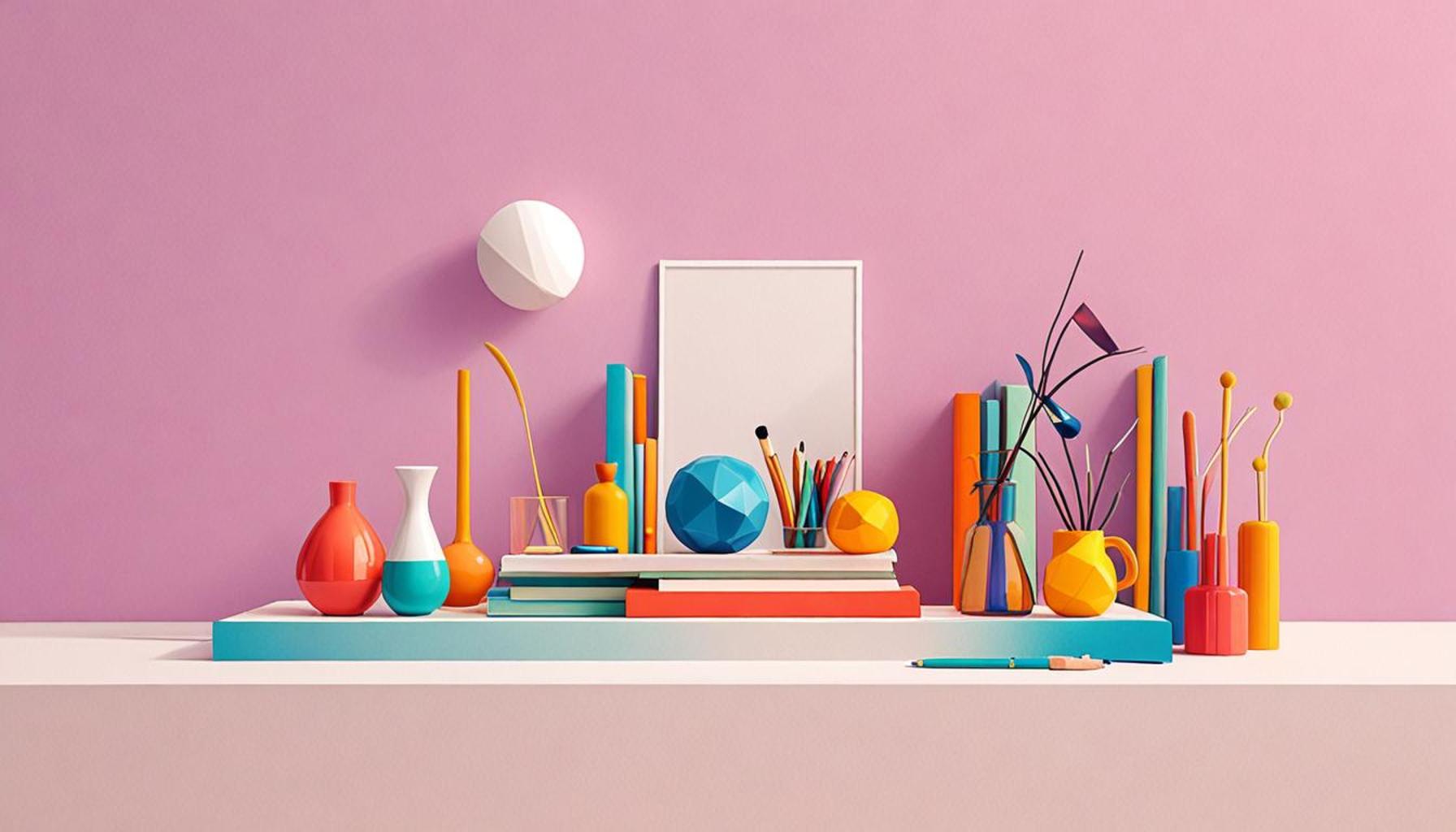The Role of Intentional Design in Reducing Stress and Improving Personal Well-Being

Understanding Stress and the Role of Design
Stress infiltrates many aspects of modern life, often deriving from relentless work schedules, personal obligations, and an overload of information. In cities across the United States, the hustle and bustle contribute to a rising tide of anxiety. However, solutions are emerging through the concept of intentional design, which goes beyond mere aesthetics to create environments that promote peace and well-being.
Physical Spaces: A Healing Environment
Physical spaces play a pivotal role in influencing our mental state. Studies have shown that environments filled with natural light can significantly uplift mood levels. For instance, many companies are now investing in biophilic design, which integrates natural elements like plant life and water features into the workplace. Research from the University of Exeter found that employees working in plantscape environments reported increased levels of well-being and productivity. Similarly, homes designed with open layouts can facilitate a sense of spaciousness, reducing feelings of claustrophobia and promoting relaxation.
Mindful Products: Daily Interactions Matter
The products we use every day can also impact our stress levels. Consider items designed with intention, such as ergonomic chairs and streamlined kitchen gadgets. For example, a user-friendly blender that minimizes messy spills can save time and reduce frustration during meal prep, allowing for a more stress-free cooking experience. By focusing on intuitive design, manufacturers help users feel more in control and less overwhelmed in their day-to-day tasks.
Digital Interfaces: Navigating the Tech Landscape
As we navigate our increasingly digital world, user-friendly applications and websites can proactively alleviate tech-related stress. Companies like Apple have set the standard with interfaces that are not only aesthetically pleasing but also highly functional. A well-designed app that minimizes clicks and enhances navigation can lead to reduced cognitive load, allowing users to engage more fully with the content without unnecessary strain. This is particularly important in the context of the overwhelming amount of information available at our fingertips.
Summarizing the Impact of Intentional Design
Research underscores that even minor adjustments in design can lead to substantial improvements in emotional health. A serene atmosphere encourages relaxation and levels out tension, while well-considered products can eliminate unnecessary challenges in our everyday routines. By creating environments that cater to our innate needs for peace and efficiency, we empower ourselves to lead more balanced lives. With intentional design as a framework, the potential to transform stressful moments into opportunities for calm and clarity is within reach. By examining these elements closely, we can all discover ways to enhance our own spaces and experiences, promoting a deeper sense of well-being.

DISCOVER MORE: Click here to learn effective decluttering strategies
The Therapeutic Influence of Nature in Design
In exploring the relationship between intentional design and personal well-being, one cannot overlook the therapeutic influence of nature within our environments. The concept of biophilia—the inherent connection humans have with nature—underscores how natural elements incorporated into design can reduce stress levels and enhance emotional health. Researchers have discovered that even simple views of greenery can diminish blood pressure and decrease stress hormones. This profound connection has led to a surge in the implementation of green spaces in urban planning, workplace architecture, and home design.
Many companies are now leveraging this science. For example, a prominent tech giant based in Silicon Valley has transformed their office environment into a veritable green sanctuary, replete with indoor gardens and water features. According to a report by the Human Spaces Global Report, exposure to natural environments can boost creativity and improve productivity by as much as 15 percent. This powerful finding illustrates the significance of peace-promoting designs that cater to our inherent affiliations with nature.
Creating Calm through Color and Texture
Beyond natural elements, the careful selection of color and texture in design can have a profound psychological impact. Colors like blue and green have been associated with feelings of calm and tranquility, while softer textures tend to evoke a sense of comfort. Designers often employ these principles when crafting personal spaces such as homes, offices, and even public buildings. A study reported in the Journal of Environmental Psychology highlighted that individuals in rooms painted in calming colors experienced lower levels of emotional distress than those in vibrantly colored environments.
Similarly, the integration of different textures can both soothe and stimulate the senses. Textured surfaces—whether it be a soft pillow, a rustic wooden table, or a smooth stone—can foster a tactile relationship that invites individuals to relax and find solace in their surroundings. By consciously considering these elements, designers can create environments that appeal to the senses and cultivate a peaceful atmosphere.
Creating Intentional Spaces: Practical Strategies
To optimize personal well-being through intentional design, here are some practical strategies everyone can consider:
- Incorporate Nature: Use plants or images of nature in your home or workspace to enhance feelings of tranquility.
- Choose Calming Colors: Opt for soft hues, like pale blues or greens, when painting your walls or selecting décor.
- Add Textural Variety: Introduce a mix of textures in your furnishings to create a comforting tactile environment.
- Design for Light: Maximize natural light in your spaces by using sheer curtains and placing mirrors strategically.
- Declutter: A tidy space can significantly reduce anxiety; design with organization in mind by incorporating smart storage solutions.
These strategies aren’t just aesthetic choices; they are critical design principles rooted in psychology that can profoundly impact stress levels and overall well-being. By understanding and applying the concepts of intentional design, individuals can create nurturing environments that foster peace and satisfaction amidst the chaos of daily life.
| Design Principle | Impact on Well-Being |
|---|---|
| Color Psychology | Colors influence moods; for example, blue hues may create a calming atmosphere. |
| Space Optimization | Efficient use of space can aid in reducing stress and clutter, enhancing focus and productivity. |
| Natural Elements | Incorporating plants and natural light can significantly improve air quality and energy levels. |
| Ergonomic Design | Furniture designed to support physical wellbeing can greatly lessen muscle tension and fatigue. |
The principles surrounding intentional design not only transform physical environments but also positively influence mental states. For instance, understanding aspects like color psychology allows individuals to create spaces that elevate moods, contributing to an overall sense of calm and well-being. Furthermore, by adopting space optimization techniques, individuals can minimize distractions, making room for creativity and clarity of thought.In the same vein, integrating natural elements into design schemes, such as live greenery and ample natural light, fosters an environment that boosts both energy and focus. Notably, ergonomic designs in furniture encourage proper posture, relieving the physical strain that often translates into mental exhaustion. These intentional design elements combined significantly foster a holistic approach to personal well-being, encouraging individuals to not just exist but thrive in their environments.
LEARN MORE: Click here to uncover the benefits of emotional decluttering
The Impact of Sound and Acoustics on Well-Being
Another integral aspect of intentional design that contributes to reducing stress and enhancing personal well-being involves the thoughtful manipulation of sound and acoustics within environments. Sound is an often-overlooked element in design; however, its ability to influence mood, productivity, and stress levels is profound. Research demonstrates that exposure to certain types of sounds, such as gentle rainfall or chirping birds, can significantly decrease stress and enhance relaxation. This concept has given rise to soundscaping, the art and science of designing audible spaces that promote a sense of tranquility and well-being.
Employing techniques such as sound masking—utilizing background noise to reduce distractions and create a more calming atmosphere—has become increasingly popular, especially in workplaces. For instance, modern offices are incorporating soundproofing measures and curated playlists featuring natural sounds to improve focus and reduce stress levels among employees. A report by the World Health Organization estimates that noise pollution can lead to increased stress levels, therefore creating quieter environments can foster greater overall well-being.
Flexible and Functional Spaces: A Pathway to Personal Empowerment
Intentional design also focuses on the functionality of spaces—ensuring that environments meet the diverse needs of individuals. Spaces that are adaptable can empower users, providing them the freedom to navigate their surroundings according to their unique preferences or situations. This flexibility can be particularly beneficial for those dealing with high levels of stress, as it allows them to tailor their environments for their emotional states.
For example, spaces like co-working environments often feature a variety of seating options, quiet zones, and collaborative areas that cater to different working styles. This design approach encourages individuals to select an area of the space that best suits their needs, balancing social interaction with the opportunity for solitude. Studio spaces designed for wellness activities—such as yoga and meditation—also emphasize this principle by allowing users to create their own calming atmosphere through rearrangement of furniture or alteration of light.
Technology-Enhanced Design: Health-Centric Innovations
In our increasingly digital world, innovations in technology-driven design have also emerged as powerful allies in the quest to foster well-being. Smart technology—such as automated lighting systems that adjust to natural light patterns—can enhance comfort and stress relief by optimizing the environment for users. For instance, illuminating spaces with warm tones can evoke feelings of relaxation, while brighter, cooler tones can boost energy and focus.
Additionally, the rise of wearable technology and health apps facilitates a deeper understanding of personal patterns and stressors. When integrated into physical environments, digital health data can inspire design choices that promote better well-being. For example, a workspace could be designed with interactive screens that provide real-time feedback on air quality, noise levels, or even employee stress, helping to create a more responsive and health-centric atmosphere.
- Emphasize Sound Quality: Consider using sound-absorbing materials in both personal and shared spaces to create a more tranquil atmosphere.
- Enhance Acoustics: Incorporate background sounds that promote relaxation, such as nature sounds or curated playlists tailored for stress relief.
- Design for Adaptability: Create flexible spaces that allow users to easily change their surroundings based on their needs and preferences.
- Utilize Smart Technology: Integrate technology that adjusts lighting and sound to suit individual moods and enhance comfort levels.
By embracing these diverse elements of intentional design, we open the door to a multitude of innovative approaches aimed at reducing stress and significantly improving personal well-being. In an era increasingly defined by fast-paced lifestyles and overwhelming pressures, intentional design offers the crucial opportunity to experience a serene and revitalizing daily life.
DISCOVER MORE: Click here to learn effective decluttering strategies
Conclusion: The Transformative Power of Intentional Design
In conclusion, the deliberate use of intentional design represents a powerful solution to the growing concerns of stress and mental health challenges facing individuals today. By integrating elements like soundscaping, flexible spaces, and innovative technology, designers can create environments that not only enhance personal well-being but also foster a sense of empowerment and adaptability. This holistic approach—centered around the user’s experience—encourages individuals to take an active role in curating their surroundings to promote relaxation and focus.
As society increasingly navigates a fast-paced and often chaotic world, the significance of healthy design becomes more apparent. From the soothing sounds of nature to the manipulation of light and space, intentional design offers various tools to create environments that support mental and emotional health. Understanding the intricate relationships between design and well-being can lead to a profound shift in personal environments, workplaces, and communities.
Ultimately, the embrace of intentional design practices not only cultivates sustainable well-being but also empowers individuals to reclaim their spaces—transforming them into sanctuaries of peace and productivity. As we move forward, it is essential to prioritize design that nurtures the human experience, paving the way for a healthier and more fulfilling future.


